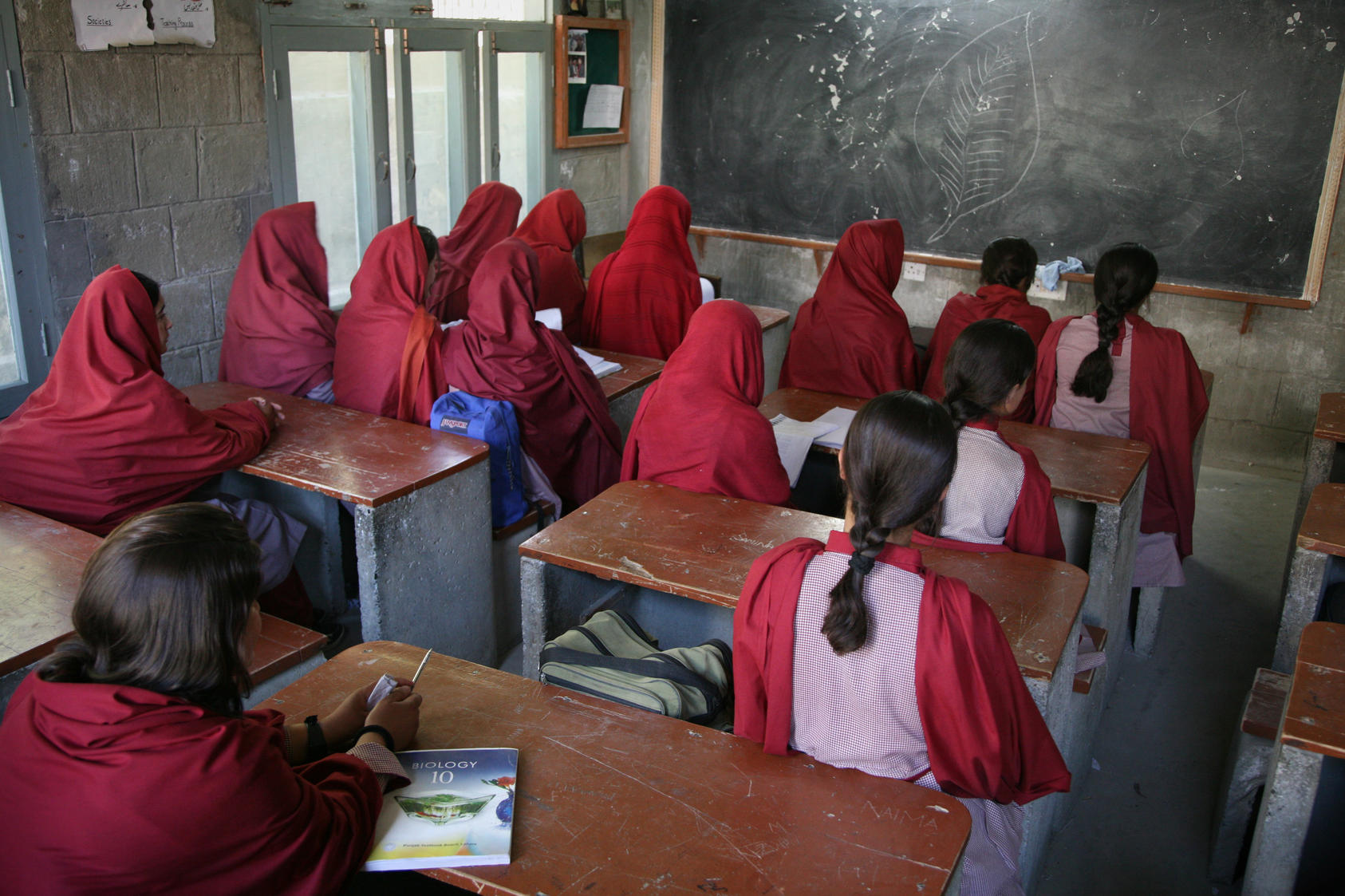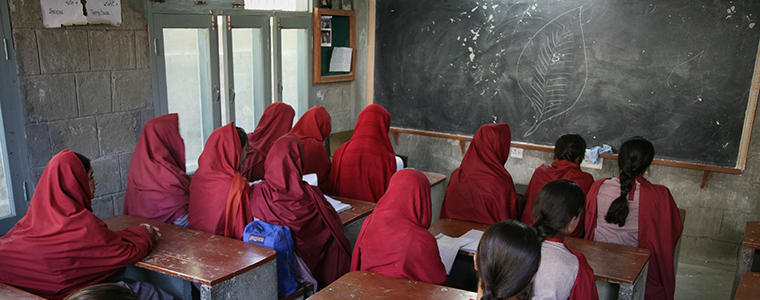Pakistan’s public school curriculum uses flawed textbooks that distort student perceptions, limit their critical thinking skills and obscure the real causes of violence and terrorism in the country, according to a study commissioned by the U.S. Institute of Peace.

“Pakistan’s current educational system does not equip students to counter the prevailing problematic narrative in society and the media,” according to Madiha Afzal, author of the study, entitled “Education and Attitudes in Pakistan; Understanding Perceptions of Terrorism.” Instead, the system “both creates and propagates narratives of its own.”
While the overwhelming majority of Pakistani school students express no “overt sympathy” or support for the Taliban – which has carried out several terrorist attacks in the country, including the December 16, 2014, assault on a school in Peshawar that killed 145 people – textbooks fail to offer a clear picture of the causes of such violence, resulting in a “confused narrative,” Afzal, an assistant professor at the University of Maryland’s school of public policy, concluded in her study.
“Ultimately the 2006 curriculum reform has brought about marginal improvements but has failed at any real change.” Researcher Madiha Afzal.
Ninth- and 10th grade students in the three of Pakistan’s four provinces that formed the focus of the study are taught that a “cunning” India has been an obstacle in Pakistan’s path dating back to 1947, when the two countries were cleaved into separate entities after gaining independence from British rule. Textbooks also portray India as creating water-sharing disputes and other obstacles to impede Pakistan’s progress. Some students also learn that the rise in terrorism incidents in the country is tied to Pakistan’s support for U.S. military efforts in neighboring Afghanistan.
While textbook content and curriculum play a role in shaping the minds of young people about the causes of violence and terrorism in the country, economic factors and a calcified bureaucracy also contribute to discontent, experts said at a June 9 discussion on the study at USIP. Without sufficient employment, more young people – 60 percent of the country’s 190 million population is below the age of 24 – may succumb to radical views, leading to more violence, panelists said.
Despite large-scale attacks carried out by the Taliban, a majority of Pakistani respondents in surveys say India “posed the greatest threat” to the country, Afzal noted during at the USIP discussion. The “dominant narrative that emerges is that foreign influences are responsible for terrorism including India, the U.S., and their agencies,” she said. Such attitudes “create an enabling environment for militants.” Afzal proposes a “massive overhauling of the curriculum” to teach students critical thinking skills as well as accurate history, which she said would help them counter conspiracy theories and falsehoods.
'Spotty' Adoption of New Materials
Afzal’s qualitative study involved a review of textbooks in the Pakistani provinces of Punjab, Sindh and Khyber-Pakhtunkhwa, as well as field visits and focus-group discussions in 23 schools in Punjab, including both government-run and private institutions.
Pakistani textbooks from the 1950s and 1960s were more “liberal” and included a well-rounded discussion of the history of the sub-continent as a whole, according to the study. But in the 1980s, during the term of then-president and military dictator General Zia-ul-Haq, a new subject called Pakistani Studies was made compulsory in schools and in advanced graduate programs. The government also instructed authors of new textbooks on the subject to “guide students towards the ultimate goal of Pakistan – the creation of a completely Islamized State.”
In 2004, then-President General Pervez Musharraf ordered a curriculum reform after facing criticism of bias in teaching materials. As part of the overhaul, a new national curriculum was developed in 2006, and in 2010 responsibility for implementation was handed down from the federal level to the provinces, according to the study.
The adoption of new materials from the curriculum has been spotty, the study concluded.
“Ultimately the 2006 curriculum reform has brought about marginal improvements but has failed at any real change,” Afzal wrote. “This is unsurprising given that the curriculum is a direct product of state policy and a narrative that justifies the existence of Pakistan with respect to India.” One male student from an “elite private school” who was interviewed for the study blamed India and the U.S. for terrorist attacks in Pakistani cities. “`We say that bomb blasts are done by Taliban and MQM [a local political party] in Karachi,’” he said, according to Afzal’s report. But then he adds, “`The major cause is the Americans and the Indians …the American agencies and the Indian agencies,” Afzal reported.
Direct Links?
Although textbooks don’t explicitly state such views, they plant the seeds by blaming India and the U.S., Afzal argues, noting that most teaching practices involve rote memorization and little critical engagement with the texts. “For many views” held by students, she says, “we saw a direct correspondence between textbook content and what the students say, which then appears to be beefed up by societal and media narratives.” Other panelists at the June 9 event questioned whether textbook content was a driver or an enabler of radical views and support for terrorism and whether curriculum reform would sufficiently address the problem.
“What does correspondence mean?” said Moeed Yusuf, director of South Asia programs at USIP, speaking of the link between curriculum and views on terrorism. “Is it correlation, causality or nothing? My own understanding is it’s very difficult to say what causes radicalization … It’s clear there’s a link. It’s clear that bad curriculum does things to minds, not only in Pakistan but around the world. But there’s also enough contrary evidence in the mindset of Pakistani youth [that doesn’t] gel with what the curriculum is saying.”
While textbook content may have some role, the “biggest variable to look at is the state,” Yusuf said. Policies adopted by successive governments and the political-ideological environment created by the government probably play a bigger role in shaping mindsets than curriculum does, he said. Curriculum reform is “definitely needed,” he said. “But whether that’ll solve Pakistan’s violence problem, I remain skeptical.”
In addition to conducting analytical research on Pakistan’s education issues, USIP supports local partners who teach peace and conflict resolution within and outside of schools. The Institute also supports teacher training and community dialogues in Pakistan designed to broaden student perspectives and encourage greater tolerance within communities.
Bureaucracy, Economy
Reforming education and curriculum would be meaningless without a large-scale transformation of the country’s economy and entrenched bureaucracy, said Nadeem Ul Haque, a former deputy chairman of Pakistan’s planning commission who attended the June 9 event.
“Education is not the problem; the problem is deep-rooted in society,” Haque said. “The state, the way it is structured … it’s a 19th Century state in the 21st Century, and nobody wants to touch the sacred cow.”
Without such reform, spending more money would be wasteful, he said. For example, the U.S. Agency for International Development and the World Bank have spent heavily on reforms, but “where has that money gone?” Haque said.
More than reforming education and curriculum, a bigger challenge for Pakistan is finding jobs for the country’s youth to allow them to escape poverty, said Michael Kugelman, a South Asia specialist at the Woodrow Wilson Center and a panelist in the USIP discussion.
Most acts of violence in Pakistan since 2001 were committed by someone under the age of 30, Kugelman noted. However, surveys and studies show that “many succumb to the blandishments of extremist ideologies regardless of their level of education.”
Even with a good education system, generating jobs is vital, Kugelman argued. Economists estimate that Pakistan needs to generate annual economic growth of about 9 percent to successfully employ its under-20 population, and yet growth is currently far lower, Kugelman said. Pakistan’s Finance Ministry estimates economic growth at 4.2 percent for the fiscal year ending this month.
